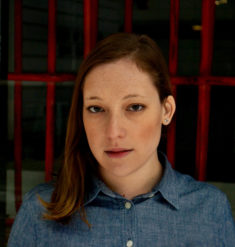Sara Nović
On September 13th, eleven floors above the bustle of midtown, a collection of Deaf poets, artists, scholars and students met alongside hearing publishing professionals to discuss the nature of ASL poetry and how it might best be sent out into the world. When it came time for DeafBlind poet John Lee Clark to present his thoughts on ProTactile language, poetry and translation, he asked the Deaf members of the audience to circle in to facilitate clearer sightlines. ProTactile (PT) is an emerging language, one that has been flourishing in the American DeafBlind community over the past decade. Borrowing sign concepts from its parent ASL, ProTactile reconfigures language to be optimal for tactile transmission. Conversants create a “contact space”—the space of their bodies, and a speaker may make signs on or in conjunction with the receiver’s body. Backchanelling—offering an affirmation of understanding, or other feedback via touches on the leg, back and shoulder—is also an important part of PT. As John presented using a PT receiver, a Certified Deaf Interpreter watched the ProTactile conversation and interpreted it into visual ASL for us, and we pulled our chairs in close to examine both languages at work. The hearing people in the audience hung back to receive the message passed in English through another layer of interpreters. As we huddled together, the poet Douglas Ridloff turned to me and said, “Deaf privilege!”
I giggled—after a morning spent discussing the ways in which ASL users are marginalized and ASL appropriated by the hearing majority, it was a sharp joke. But it was also a truth revealed again and again throughout our time together.
I’m not a poet in any language, but I am a lover of poetry in both ASL and English. I was starstruck to be in the room with masters like Peter Cook, who I’d grown up watching on the internet, and leading thinkers like Ben Bahan and Dirksen Bauman, whose work I teach in my courses.
In a busy day of workshops we considered the poetics of ASL and, particularly, the nuts and bolts of how to publish it. Bahan and Baumen kicked off the afternoon with a brief history of signed languages from the ancient world to today. Peter Cook and Kenny Lerner—together a Deaf-hearing poetry duo known as Flying Words Project—highlighted the value of language play and the humor waiting to be tapped in a bilingual ASL-English poem. Artist Adrean Clark offered thoughts on using comics, pop-up books and ASLwrite, a signwriting system, to get sign language on paper, as well as ways in which ASL might function as a subtext in visual art. Douglas Ridloff, in collaboration with poet and activist Bob Holman, shared their experience of publishing ASL poetry as a flip book, and by video with supplemental English translation. Joan Naturale discussed the archiving of ASL poetry and storytelling films at RIT/NTID, and Patrick Boudreault unveiled new strategies for hosting and translating ASL poetry and academic work within Gallaudet’s Deaf Studies Digital Journal.
As we shifted from an intimate discussion to public panels and performances in the evening, Deaf scholar Rachel Mazique began the night with a presentation on her personal journey of language and scholarship, and an examination of how we define the canon and “literature,” particularly Deaf literature. From there we raised and continued to expand upon the day’s questions: How can we best use technology to make ASL poetry available and accessible to viewers? How can we get people to respect ASL poetry without a widely used written form? Could growing the use of a sign writing system be a way to garner respect for a language in an industry where so much value is placed on the written word? To what extent is effective translation from ASL into English possible, and more importantly, is it beneficial? Could a hybrid English serve to support the goals of an ASL poem, or will the dominant language always mine the marginalized one to add to its own value? And how can we create a platform for ASL poetry that filters for quality but is also attuned to breaking down systematic barriers that prevent the intersectionally marginalized from reaching an audience?
We sought answers in postcolonial theory, in translation theory, in technology, in the visual arts. We agreed, disagreed, and answered one question only to have ten more spring forth.
But most of all, we reveled in the talent of the poets before us and in the capacity for ASL to carry a multilayered narrative, metaphor, humor, and lyricism simultaneously.
The thing I love most about ASL is that it forces us into action, to throw the weight of our bodies behind what we say, to gather around one another in community, to make eye contact or physically touch. While English’s vast reach does offer a degree of power, that power is so often equated with an inherent superiority that, even beginning viewers of ASL poetry in the audience could see by night’s end, simply does not exist. As we continue to grapple with and answer the logistical questions surrounding the publication of works in ASL, I hope more viewers will have the opportunity see these long-internalized power structures crumble under the vivacity of an ASL poem. Spoken language so often falls short in comparison to what we can do with our whole bodies—and that is truly a Deaf privilege.

